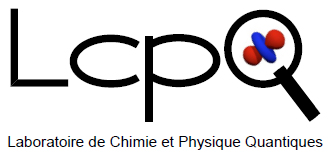Development of an Ab-Initio Quality Potential for modeling Asphaltenes at the Water/Solvent interface using AI tools
THEORETICAL CHEMISTRY AND COMPUTATIONAL MODELING

Lab: LCPQ
Duration: NanoX master Internship (8 months part-time in-lab immersion)
5 months full-time internship
6 months full-time internship
Latest starting date: 08/01/2024
Localisation: Laboratoire de Chimie et Physique Quantiques (LCPQ)- FeRMI Institute
University Toulouse 3, Build. 3R4
118 route de Narbonne
31062 Toulouse Cedex 09, France
Supervisors:
SIMON Aude aude.simon@irsamc.ups-tlse.fr
CUNY Jérôme jerome.cuny@irsamc.ups-tlse.fr
This research master's degree project could be followed by a PhD
Work package:
The present Master project enters the framework of a multi-scale multi-method approach dedicated to improve our understanding of the physical and chemical properties of systems of interest in oil industry in order to improve energetic processes.
Asphaltenes are polycyclic aromatic hydrocarbons (PAH) possibly including heteroatoms such as nitrogen or sulfur, as well as alkyl side chains (see Figure 1). They are regarded as the most enigmatic component in petroleum because of their negative influence on stabilizing the water-in-crude oil emulsion. The main goal of this Master project will be to improve our understanding of the interfacial properties between liquid water and a non aqueous solvent in the presence of asphaltene aggregates. This will be achieved through the analysis of structural, energetic and thermodynamics data obtained from ab initio molecular dynamics simulations (MD).
However, conventional quantum chemical methods are ways too expensive to model such complex systems. To overcome this limitation, we intend to develop a potential that can treat large size systems at a limited computational cost while conserving an ab-initio quality. To reach this objective, a potential based on deep neural networks (Deep Neural Network Potential; DNNP) will be built from data produced from high quality quantum chemical calculations [1]. Thousands of structures considering various types of asphaltenes will thus be generated and obtained under different temperature conditions. Once re-calculated at the DFT level with a high quality functional (for instance revPBE0-D3), the structures, energies and forces will constitute the training set of the DNNP potential. The exact definition of this set, the chemical descriptors, the definition of the DNNP are the parameters that will need to be defined and tested. To do this, we will use the DeePMD kit [2], specifically developed to build DNNP potentials for MD applications and which we are already using at the LCPQ.
In the case of the liquid water/non aqueous solvent interface, preliminary studies have been achieved on the water/liquid benzene interface perturbed by the presence of clusters of coronene C24H12. In this case, the future Master student’s work will consist in:
-(i)- Generating a DNNP potential for C24H12 at the liquid water/non aqueous solvent interface.
-(ii)- Benchmarking the DNNP potential to evaluate its reliability and the quality of the training data.
-(iii)- Applying the DNNP potential to model systems to compare its performances with published results [3].
-(iv)- Trying to automatically extend the DNNP potential to other chemical compositions: introduction of heteroatoms (O, N, and S) and alkyl side chains, change the nature of the solvent.

References:
1] M. de la Puente, R. David, A. Gomez,D. Laage, J. Am. Chem. Soc., 144, 23, 10524-10529 (2022).
[2] H. Wang, L. Zhang, J. Han, E. Weinan, Comput. Phys. Comm., 228, 178-184 (2018).
[3] R. Vacha, P. Jungwirth, J. Chen and K. Valsaraj, Phys. Chem. Chem. Phys., 8, 4461–4467 (2006).
Areas of expertise:
Machine Learning ; Molecular dynamics ; PAH ; Asphaltenes; Liquid Water ; Liquid-Liquid Interface
Required skills for the internship:
Applicant must have a background in physics or chemistry and must have skills in theoretical chemistry and be interested in using computational tools. Skills in programming languages such as Bash, Python and Fortran are a plus but are not compulsory.
